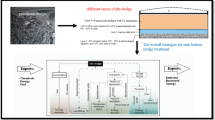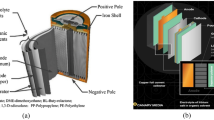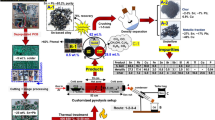Abstract
Technological development has led to a growing generation of waste electrical and electronic equipment, including cables. This work concerns the recycling of coaxial cables using two less common configurations of electrostatic separators. At first, the cables were comminuted and sieved. Then, they were subjected to electrostatic separation on the plate-type and the screen-type electrostatic separators. The performance of each separator was evaluated according to important parameters, including high voltage, plate angle, and splitter angle. In the sieving step, purity of 99.21% and recovery efficiency of 93.67% for aluminium were achieved. In regards to the electrostatic separation, for plate-type, the best parameters were a high voltage of 30 kV, a plate angle of 50°, and a splitter angle of − 7.5°, achieving purity of 90.86% and recovery efficiency of 88.65% for copper-clad steel. For screen-type, the best parameters were a high voltage of 30 kV, and a plate angle of 70º, attaining purity of 87.27%, and recovery efficiency of 79.86% for copper-clad steel. The results showed that the plate-type was better suited for the recovery of materials from coaxial cables, contributing to increasing the information available about these configurations and helping in the use of these separators on other types of waste.








Similar content being viewed by others
References
Forti V, Baldé CP, Kuehr R, Bel G (2020) The global E-waste monitor 2020: quantities flows and the circular economy potential. United Nations University/United Nations Institute for Training and Research, International Telecommunication Union, and International Solid Waste, Bonn/Geneva/Rotterdam
Ismail H, Hanafiah MM (2019) An overview of LCA application in WEEE management: current practices, progress and challenges. J Clean Prod 232:79–93
Li L, Liu G, Pan D et al (2017) Overview of the recycling technology for copper-containing cables. Resour Conserv Recycl 126:132–140. https://doi.org/10.1016/j.resconrec.2017.07.024
Ko DC, Lee SK, Kim BM et al (2007) Evaluation of copper coating ratio in steel/copper clad wire drwaing. J Mater Process Technol 186:22–26
Suresh SS, Mohanty S, Nayak SK (2017) Composition analysis and characterization of waste polyvinyl chloride (PVC) recovered from data cables. Waste Manag 60:100–111. https://doi.org/10.1016/j.wasman.2016.08.033
Xiao S, Xiong W, Wang L et al (2016) The treatment technology of recycling scrap wire and cable. In: 4th International conference on sustainable energy and environmental engineering (ICSEEE 2015), pp 500–503. https://doi.org/10.2991/icseee-15.2016.82
de Araújo MCPB, Chaves AP, Espinosa DCR et al (2008) Electronic scraps - recovering of valuable materials from parallel wire cables. Waste Manag 28:2177–2182
Barbakadze K, Brostow W, Granowski G et al (2018) Separation of metal and plastic wastes from wire and cable manufacturing for effective recycling. Resour Conserv Recycl 139:251–258. https://doi.org/10.1016/j.resconrec.2018.06.022
Pita F, Castilho A (2018) Separation of copper from electric cable waste based on mineral processing methods: a case study. Minerals 8:1–12
Tanabe EH, Silva RM, Júnior DLO et al (2019) Recovery of valuable metals from waste cables by employing mechanical processing followed by spouted bed elutriation. Particuology 45:74–80. https://doi.org/10.1016/j.partic.2018.12.002
Martins TR, Mrozinski NS, Bertuol DA et al (2020) Recovery of copper and aluminium from coaxial cable wastes using comparative mechanical processes analysis. Environ Technol (United Kingdom) 197:1–13. https://doi.org/10.1080/09593330.2020.1725141
Bedeković G, Trbović R (2020) Electrostatic separation of aluminium from residue of electric cables recycling process. Waste Manag 108:21–27
Djillali A, Fethi BM, Tilmatine A (2021) Electrostatic separation of particles used as complement to mechanical recycling plant of industrial waste. Int J Environ Stud. https://doi.org/10.1080/00207233.2021.1875293
Dascalescu L (1993) Numerical analysis of the electric field of roll-type electrostatic separators. J Electrostat 29:255–267
Silveira AVM, Santana MP, Tanabe EH et al (2017) Recovery of valuable materials from spent lithium ion batteries using electrostatic separation. Int J Miner Process 169:91–98. https://doi.org/10.1016/j.minpro.2017.11.003
Younes M, Tilmatine A, Medles K et al (2007) Numerical modeling of conductive particle trajectories in roll-type corona-electrostatic separators. IEEE Trans Ind Appl 43:1130–1136
Younes M, Tilmatine A, Medles K et al (2009) Numerical modeling of insulating particles trajectories in roll-type corona-electrostatic separators. IEEE Trans Dielectr Electr Insul 16:629–634
Silveira AVM, Cella M, Tanabe EH et al (2018) Application of tribo-electrostatic separation in the recycling of plastic wastes. Process Saf Environ Prot 114:219–228. https://doi.org/10.1016/j.psep.2017.12.019
Shi J, Zhao X, Zhang Z et al (2021) Theoretical and experimental study on the triboelectric separation of ternary plastics combination using fluidized bed. J Mater Cycles Waste Manag 23:2297–2306. https://doi.org/10.1007/s10163-021-01296-3
Samuila A, Urs A, Iuga A et al (2005) Optimization of corona electrode position in roll-type electrostatic separators. IEEE Trans Ind Appl 41:527–534
Richard G, Touhami S, Zeghloul T et al (2017) Optimization of metals and plastics recovery from electric cable wastes using a plate-type electrostatic separator. Waste Manag 60:112–122. https://doi.org/10.1016/j.wasman.2016.06.036
Iuga A, Vlad S, Mihailescu M et al (2004) A laboratory plate/screen-type electrostatic separator for granular mixtures: design, engineering, and application. Part Sci Technol 22:275–283
Richard G, Touhami S, Zeghloul T et al (2017) Experimental and numerical evaluation of two electrode systems for plate-type electrostatic separators. J Electrostat 85:1–10. https://doi.org/10.1016/j.elstat.2016.11.002
Dascalescu TZL, Dascalescu L, Touhami S et al (2015) Corona-assisted plate-type electrostatic separation process for granular plastic wastes. In: IEEE Industry Applications Society annual meeting, pp 1–6. https://doi.org/10.1109/IAS.2015.7356772
Vlad S, Iuga A, Dascalescu L (2000) Modelling of conducting particle behaviour in plate-type electrostatic separators. J Phys D Appl Phys 33:127–133
Salama A, Richard G, Medles K et al (2018) Distinct recovery of copper and aluminum from waste electric wires using a roll-type electrostatic separator. Waste Manag 76:207–216. https://doi.org/10.1016/j.wasman.2018.03.036
Acknowledgements
The authors would like to thank CNPq (National Council of Science and Technological Development), CAPES (Brazilian Agency for Improvement of Graduate Personnel), FAPERGS (Research Support Foundation of the State of Rio Grande do Sul), and SDECT (Secretary of Economic Development, Science and Technology of the State of Rio Grande do Sul) for financial support.
Author information
Authors and Affiliations
Corresponding author
Ethics declarations
Conflict of interest
The authors declare that they have no known competing financial interests or personal relationships that could have appeared to influence the work reported in this paper.
Additional information
Publisher's Note
Springer Nature remains neutral with regard to jurisdictional claims in published maps and institutional affiliations.
Rights and permissions
About this article
Cite this article
Martins, T.R., Bertuol, D.A. & Tanabe, E.H. Recovery of metals and polymers from coaxial cables using different configurations of electrostatic separators. J Mater Cycles Waste Manag 24, 633–641 (2022). https://doi.org/10.1007/s10163-021-01346-w
Received:
Accepted:
Published:
Issue Date:
DOI: https://doi.org/10.1007/s10163-021-01346-w




